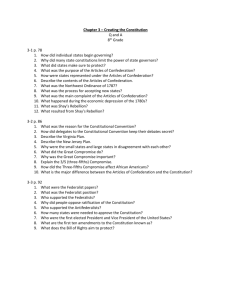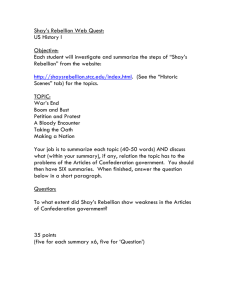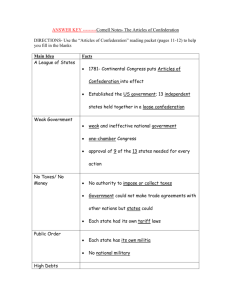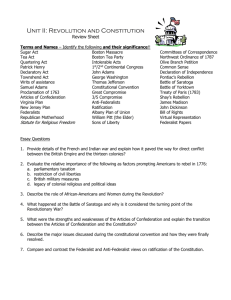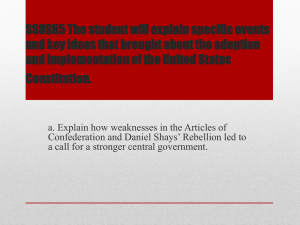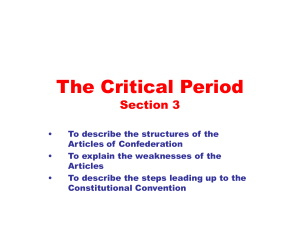The Articles of Confederation and Constitutional Convention
advertisement
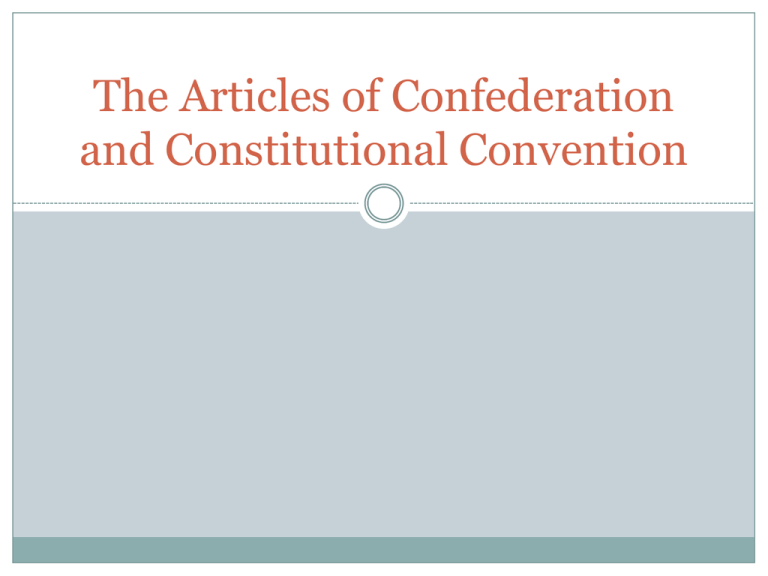
The Articles of Confederation and Constitutional Convention Off the Bat: Wed/Thurs If you were to create your own Constitution, what laws/ideas would you include? Explain at least 3 components. Agenda 1. Notes: The Articles of Confederation 2. Intro to Shay’s Rebellion 3. Read documents pertaining to Shay’s Rebellion and discuss colonists’ reactions 4. Notes: The Constitutional Convention The Articles of Confederation https://prezi.com/ros6ntsov2lv/copy-of-articles-of- confederation/ Why were the Articles of Confederation so weak? What we didn’t like about the British. . . So the Articles of Confederation… • Taxation without representation • Large central government (monarchy) had all the power • States always had to listen to the king • All power was in the King’s hands. • King could change the rules/laws any time • Federal government could not tax • States didn’t have to follow laws and treaties. • States had their own laws and didn’t have to follow any other states’ laws • No executive branch or national court system. • Any amendment required all 13 states What’s the Problem? Federal government could not tax; very difficult to raise money. States didn’t have to follow laws and treaties. Each State had its own laws. No executive branch or national court system. Any amendment required all 13 states, so very difficult to modify. Shay’s Rebellion Read the “textbook account” of Shay’s Rebellion. • What happened in Shay’s rebellion? • How is it connected to the Articles of Confederation? • According to the textbook, how did Americans respond? Central Questions Did all Americans think the Articles of Confederation were too weak? How did Americans react to Shays’ Rebellion? Assignment Read the documents and respond Write 1 paragraph in response to the question: “Why did the Articles of Confederation fail?” The Constitutional Convention After 10 years living under the Articles, it was clear the loose association of 13 independent states was not working. National govt. needed to be strengthened. Delegates met in Philadelphia. All attended except Rhode Island. The Convention Began May 25, 1787 in Independence Hall. 55 men: well-educated, lawyers, merchants, college presidents, generals, governors, planters 8 were signers of the Declaration of Independence Native Americans, African Americans, women not included The Delegates Chose George Washington to preside Agreed that all sates would have one vote Simple majority (7 votes) would decide any issue Work would be secret Only details today come from a notebook kept by James Madison of Virginia A New Constitution Delegates quickly decided that the Articles were beyond fixing and set about creating a new constitution. Virginia Plan Proposed by James Madison and Edmund Randolph Included a president, courts, and Congress with 2 houses. Representation in each house would be based on a state’s population. Who would this appeal to? The New Jersey Plan Called for a government similar to the one under the Articles. One house Congress with equal representation for each state Congress could set taxes and regulate trade Who would this appeal to? The Great Compromise Combination of New Jersey and Virginia Plans Proposed by Roger Sherman of Connecticut 2 Houses Three-Fifths Compromise More than 550,000 African Americans enslaved in the South Issue: Should they be counted for population? South said yes: WHY? North said no: WHY? Compromise: Every 5 enslaved people would count as 3 free people Other Compromises Issue of trade -North believed Congress should regulate foreign trade and trade between states -South feared tax on exports and limits on slave trade Compromise: Congress could regulate trade but could not tax exports or interfere with the slave trade before 1808 Electing the President Some believed Congress should choose the President, others believed the people should vote Compromise: The Electoral College Delegates worked throughout the summer Constitution signed September 17, 1787 (All but 3 delegates signed) Constitution had to be ratified (approved) by 9/13 states to take effect
